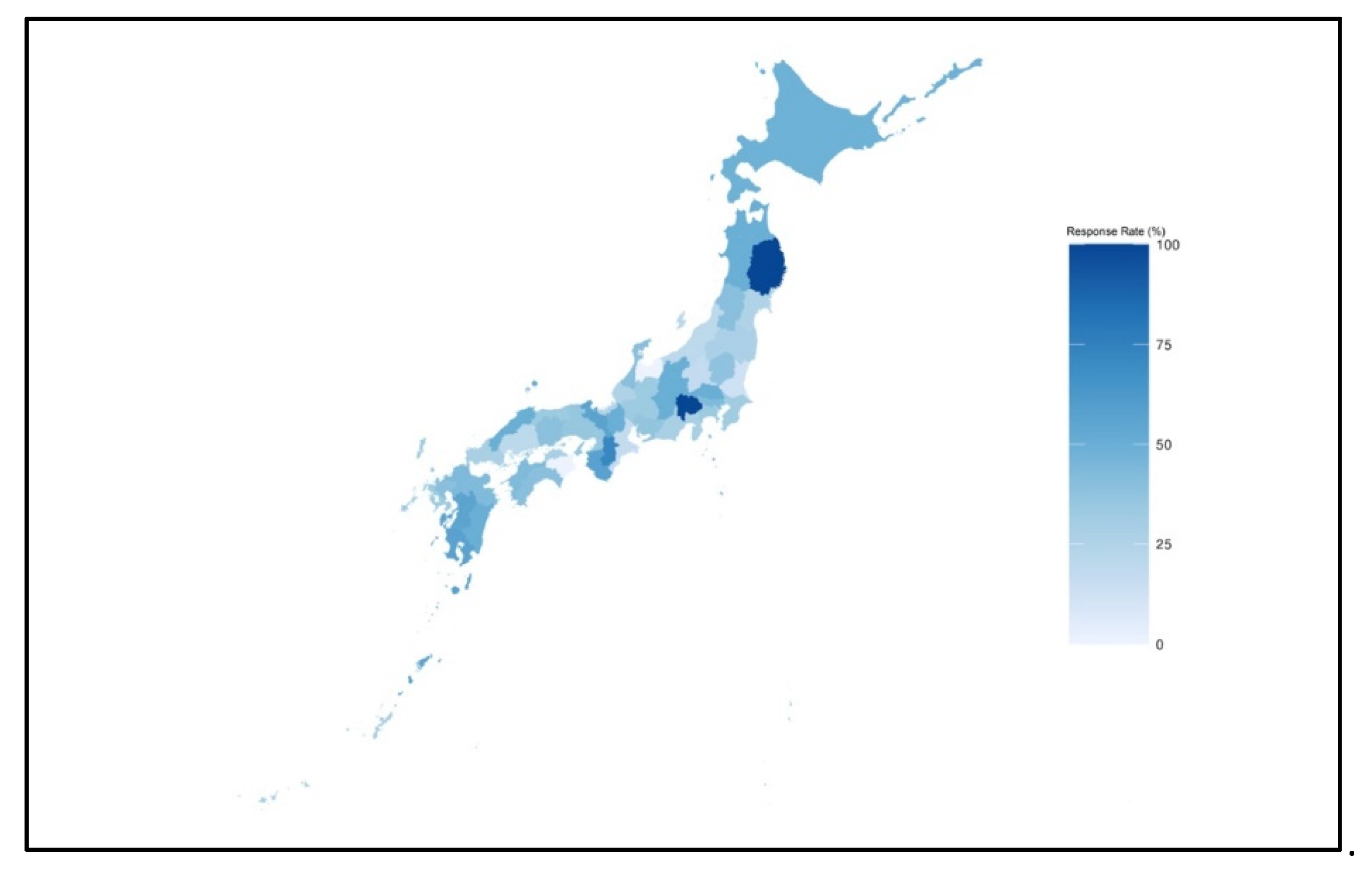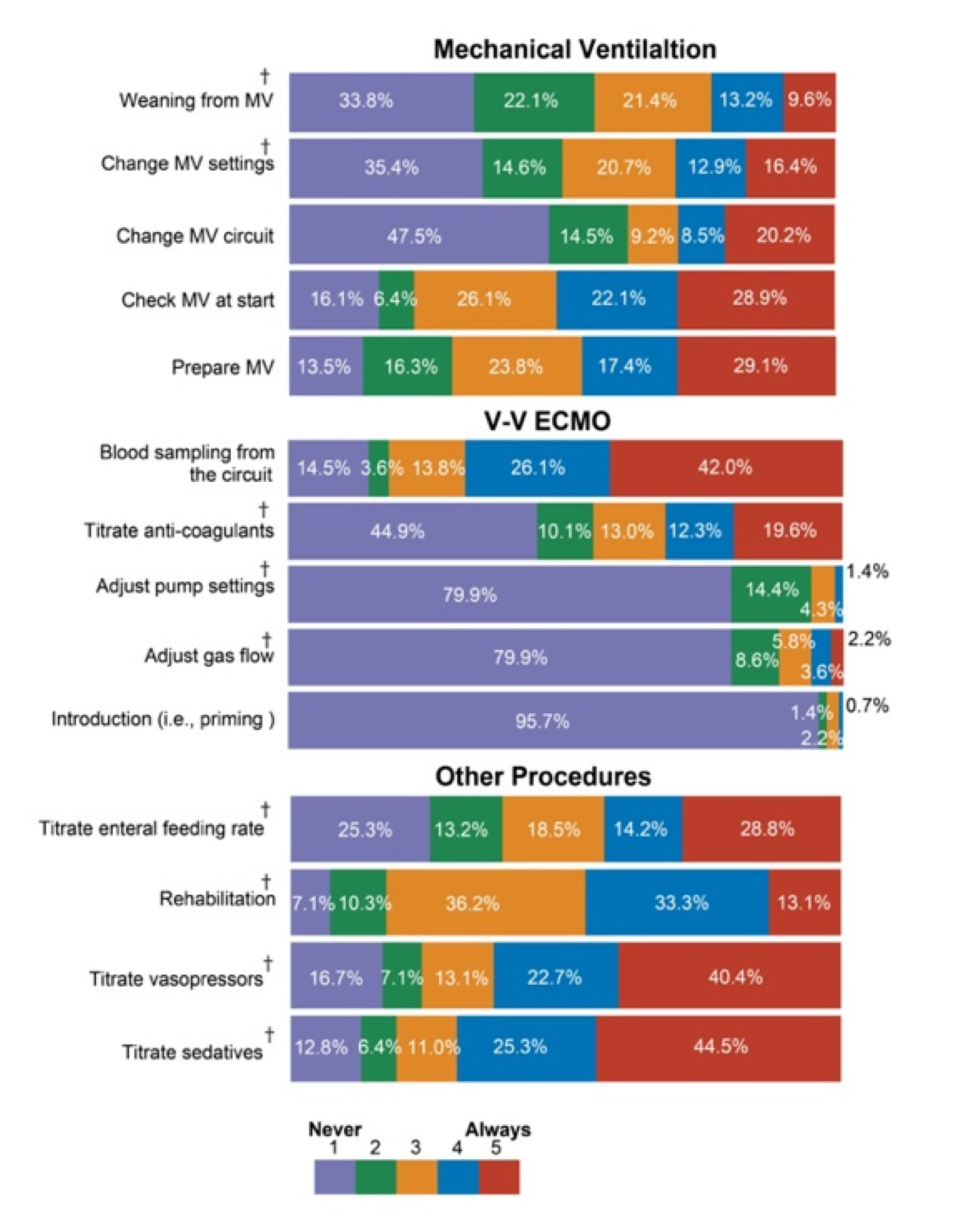Workforce and Task Sharing of Nurses in the Japanese Intensive Care Unit-Cross-Sectional Postal Survey
Abstract
:1. Introduction
2. Materials and Methods
2.1. Study Design
2.2. Participants and Setting
2.3. Variables
2.4. Measurement
2.5. Data Analysis
2.6. Ethical Considerations
3. Results
4. Discussion
5. Limitations
6. Conclusions
Author Contributions
Funding
Institutional Review Board Statement
Informed Consent Statement
Data Availability Statement
Acknowledgments
Conflicts of Interest
References
- Fujii, Y.; Hirota, K. Critical care demand and intensive care supply for patients in Japan with COVID-19 at the time of the state of emergency declaration in April 2020: A descriptive analysis. Medicina 2020, 56, 530. [Google Scholar] [CrossRef] [PubMed]
- Marks, S.; Edwards, S.; Jerge, E.H. Rapid Deployment of critical care nurse education during the COVID-19 pandemic. Nurse Lead 2021, 19, 165–169. [Google Scholar] [CrossRef] [PubMed]
- Ministry of Health, Labour and Welfare, Japan. Facility Standards for Basic Medical Fees. Available online: https://www.mhlw.go.jp/web/t_doc?dataId=84aa9732&dataType=0 (accessed on 1 June 2021). (In Japanese).
- Ministry of Health, Labour and Welfare Hospital Bed Function Report. 2018. Available online: https://www.mhlw.go.jp/stf/seisakunitsuite/bunya/open_data_00005.html (accessed on 1 June 2021). (In Japanese).
- Farnell, S.; Dawson, D. “It’s not like the wards”. Experiences of nurses new to critical care: A qualitative study. Int. J. Nurs. Stud. 2006, 43, 319–331. [Google Scholar] [CrossRef] [PubMed]
- Hirzallah, F.M.; Alkaissi, A.; Barbieri-Figueiredo, M.d.C. A systematic review of nurse-led weaning protocol for mechanically ventilated adult patients. Nurs. Crit. Care 2019, 24, 89–96. [Google Scholar] [CrossRef] [PubMed]
- Arias-Rivera, S.; Sánchez-Sánchez, M.d.M.; Santos-Díaz, R.; Gallardo-Murillo, J.; Sánchez-Izquierdo, R.; Frutos-Vivar, F.; Ferguson, N.D.; Esteban, A. Effect of a nursing-implemented sedation protocol on weaning outcome. Crit. Care Med. 2008, 36, 2054–2060. [Google Scholar] [CrossRef] [PubMed]
- Hamamoto, M.; Unoki, T.; Tamoto, M.; Sakuramoto, H.; Kawai, Y.; Miyamoto, T.; Ito, Y.; Moro, E.; Tatsuno, J.; Nishida, O. Survey on the actual number of nurses required for critical patients with COVID-19 in Japanese intensive care units: Preliminary report. Jpn. J. Nurs. Sci. 2021, e12424. [Google Scholar]
- Rose, L.; Nelson, S.; Johnston, L.; Presneill, J.J. Workforce profile, organisation structure and role responsibility for ventilation and weaning practices in Australia and New Zealand intensive care units. J. Clin. Nurs. 2008, 17, 1035–1043. [Google Scholar] [CrossRef] [PubMed]
- Law, A.C.; Stevens, J.P.; Hohmann, S.; Walkey, A.J. Patient Outcomes After the introduction of statewide ICU nurse staffing regulations. Crit. Care Med. 2018, 46, 1563–1569. [Google Scholar] [CrossRef] [PubMed]
- Bakhru, R.N.; McWilliams, D.J.; Wiebe, D.J.; Spuhler, V.J.; Schweickert, W.D. Intensive care unit structure variation and implications for early mobilization practices. An international survey. Ann. Am. Thorac. Soc. 2016, 13, 1527–1537. [Google Scholar] [CrossRef] [PubMed] [Green Version]
- Checkley, W.; Martin, G.S.; Brown, S.M.; Chang, S.Y.; Dabbagh, O.; Fremont, R.D.; Girard, T.D.; Rice, T.W.; Howell, M.D.; Johnson, S.B.; et al. Structure, process, and annual ICU mortality across 69 centers: United States critical Illness and injury trials group critical illness outcomes study. Crit. Care Med. 2014, 42, 344–356. [Google Scholar] [CrossRef] [PubMed] [Green Version]
- Sakr, Y.; Moreira, C.L.; Rhodes, A.; Ferguson, N.D.; Kleinpell, R.; Pickkers, P.; Kuiper, M.A.; Lipman, J.; Vincent, J.-L. Extended prevalence of infection in intensive care study investigators the impact of hospital and ICU organizational factors on outcome in critically ill patients: Results from the extended prevalence of infection in intensive care study. Crit. Care Med. 2015, 43, 519–526. [Google Scholar] [CrossRef] [PubMed] [Green Version]
- Kane, C.; Galanes, S. Adult respiratory distress syndrome. Crit. Care Nurs. Q. 2004, 27, 325–335. [Google Scholar] [CrossRef] [PubMed]
- Lahti, M.; Kontio, R.; Pitkänen, A.; Välimäki, M. Knowledge transfer from an e-learning course to clinical practice. Nurse Educ. Today 2014, 34, 842–847. [Google Scholar] [CrossRef] [PubMed]
- Daly, K.J.; Camporota, L.; Barrett, N.A. An international survey: The role of specialist nurses in adult respiratory extracorporeal membrane oxygenation. Nurs. Crit. Care 2017, 22, 305–311. [Google Scholar] [CrossRef] [PubMed]
- Umeda, A.; Sugiki, Y. Nursing care for patients with COVID-19 on extracorporeal membrane oxygenation (ECMO) support. Glob. Health Med. 2020, 2, 127–130. [Google Scholar] [CrossRef] [PubMed] [Green Version]
- Aokage, T.; Palmér, K.; Ichiba, S.; Takeda, S. Extracorporeal membrane oxygenation for acute respiratory distress syndrome. J. Intensive Care Med. 2015, 3, 17. [Google Scholar] [CrossRef] [PubMed] [Green Version]
- Shime, N. Clinical and investigative critical care medicine in Japan. Intensive Care Med. 2016, 42, 453–455. [Google Scholar] [CrossRef] [PubMed] [Green Version]
- Committee on ICU-CE. Japanese society of intensive care medicine evaluation of clinical engineer in ICU. J. Jpn. Soc. Intensive Care Med. 2019, 26, 139–148. [Google Scholar] [CrossRef] [Green Version]
- Qi, Z.; Yang, S.; Qu, J.; Li, M.; Zheng, J.; Huang, R.; Yang, Z.; Han, Q.; Li, H. Effects of nurse-led sedation protocols on mechanically ventilated intensive care adults: A systematic review and meta-analysis. Aust. Crit. Care 2020, 34, 278–286. [Google Scholar] [CrossRef] [PubMed]
- Ramoo, V.; Abdullah, K.L.; Tan, P.S.; Wong, L.P.; Chua, P.Y. Intervention to improve intensive care nurses’ knowledge of sedation assessment and management. Nurs. Crit. Care 2016, 21, 287–294. [Google Scholar] [CrossRef] [PubMed]


| Variables | Values |
|---|---|
| Type of hospital (%), n = 282 | |
| University hospital | 73 (25.9%) |
| Missing | 5 (1.8%) |
| Type of ICU based on medical fee (%), n = 282 | |
| ICU type 1, 2 | 108 (38.3%) |
| ICU type 3, 4 | 130 (46.1%) |
| Emergency ICU 2, 4 | 44 (15.6%) |
| Physician staffing (%), n = 282 | |
| Closed ICU † | 21 (7.4%) |
| Mandatory intensivist consultation | 156 (55.3%) |
| Elective intensivist consultation | 48 (17%) |
| No intensivist | 56 (19.9%) |
| Missing | 1 (0.4%) |
| ICU beds and Nurse staffing | |
| Number of ICU beds, median [IQR], n = 282 | 8 (6–12) |
| Number of ICU nurses, median [IQR], n = 265 | 30 (22–38) |
| Proportion for number of nurses with <1 year of ICU experience, median [IQR], n = 263 | 15.6% (11.1–22.6) |
| No certified nurse or certified nurse specialist, n (%), n = 282 | 41 (14.5%) |
| Variables | Values |
|---|---|
| Mechanical Ventilation for Severe Respiratory Failure | |
| Number of nurses independently caring for the specified population in a unit, median (IQR), n = 259 ICUs | 17 (12–23) |
| Proportion of nurses independently caring for the specified population in a unit, median (IQR), n = 259 ICUs | 60 (42.3–77.3) |
| VV-ECMO for Severe Respiratory Failure | |
| Characteristics of ICU using VV-ECMO, n = 133 ICUs | |
| University hospital, n (%), n = 129 ICUs † | 48 (37%) |
| Number of cases with VV-ECMO per a year, median [IQR], n = 133 | 2 (1–5) |
| Nurses independently providing care for VV-ECMO, n = 133 ICUs | |
| Number of nurses independently caring for the specified population in a unit, median (IQR), n = 117 ICUs * | 15 (10–21) |
| Proportion of nurses independently caring for the specified population in a unit, median (IQR), n = 117 ICUs * | 46.9 (35.7–63.3) |
Publisher’s Note: MDPI stays neutral with regard to jurisdictional claims in published maps and institutional affiliations. |
© 2021 by the authors. Licensee MDPI, Basel, Switzerland. This article is an open access article distributed under the terms and conditions of the Creative Commons Attribution (CC BY) license (https://creativecommons.org/licenses/by/4.0/).
Share and Cite
Unoki, T.; Kawai, Y.; Hamamoto, M.; Tamoto, M.; Miyamoto, T.; Sakuramoto, H.; Ito, Y.; Moro, E.; Tatsuno, J.; Nishida, O. Workforce and Task Sharing of Nurses in the Japanese Intensive Care Unit-Cross-Sectional Postal Survey. Healthcare 2021, 9, 1017. https://doi.org/10.3390/healthcare9081017
Unoki T, Kawai Y, Hamamoto M, Tamoto M, Miyamoto T, Sakuramoto H, Ito Y, Moro E, Tatsuno J, Nishida O. Workforce and Task Sharing of Nurses in the Japanese Intensive Care Unit-Cross-Sectional Postal Survey. Healthcare. 2021; 9(8):1017. https://doi.org/10.3390/healthcare9081017
Chicago/Turabian StyleUnoki, Takeshi, Yusuke Kawai, Miya Hamamoto, Mitsuhiro Tamoto, Takeharu Miyamoto, Hideaki Sakuramoto, Yumi Ito, Etsuko Moro, Junko Tatsuno, and Osamu Nishida. 2021. "Workforce and Task Sharing of Nurses in the Japanese Intensive Care Unit-Cross-Sectional Postal Survey" Healthcare 9, no. 8: 1017. https://doi.org/10.3390/healthcare9081017
APA StyleUnoki, T., Kawai, Y., Hamamoto, M., Tamoto, M., Miyamoto, T., Sakuramoto, H., Ito, Y., Moro, E., Tatsuno, J., & Nishida, O. (2021). Workforce and Task Sharing of Nurses in the Japanese Intensive Care Unit-Cross-Sectional Postal Survey. Healthcare, 9(8), 1017. https://doi.org/10.3390/healthcare9081017







